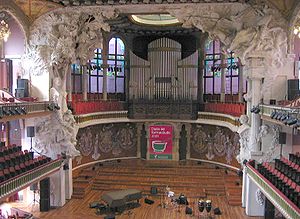| FAREWELL WORLD TOUR - BARCELONA - SPAIN 14th March 2008 | 公開範囲:全ユーザー |
Palau de La Musica
Barcelona - Spain
" FESTIVAL MIL·LENNI "
Friday 14th March 2008
21.30hrs
The Palau de la Música Catalana (Palace of Catalan Music) is a concert hall designed in the Catalan modernisme style by the architect Lluís Domènech i Montaner. It was built in Barcelona, Catalonia, Spain, between 1905 and 1908 for the Orfeó Català, a choral society founded in 1891 that was a leading force in the Catalan cultural and political independence movement that came to be known as the Renaixença (Catalan Rebirth) (Benton 1986, 56; Fahr-Becker 2004, 199). it was inaugurated February 9 1908.
The project was financed primarily by the society, but important financial contributions also were made by Barcelona's wealthy industrialists and bourgeoisie. The Palau won the architect an award from the Barcelona City Council in 1909, given to the best building built during the previous year. Between 1982 and 1989, the building underwent extensive restoration, remodeling, and extension under the direction of architects Oscar Tusquets and Carles Díaz (Carandell et al. 2006, 138). In 1997, the Palau de la Música Catalana was declared a UNESCO World Heritage Site along with Hospital de Sant Pau. Today, more than half a million people a year attend musical performances in the Palau that range from symphonic and chamber music to jazz and Cançó (Catalan song).
The concert hall is one of the most beautiful in the world (...) without exaggeration. It is one of its most important architectural treasures. Its pace, simple, complex, mystical and paradoxical, defies accurate description.
-David Mackay
(Quoted in Carandell et al. 2006, 62)
The concert hall of the Palau, which seats about 2,200 people, is the only auditorium in Europe that is illuminated during daylight hours entirely by natural light. The walls on two sides consist primarily of stained-glass panes set in magnificent arches, and overhead is an enormous skylight of stained glass designed by Antoni Rigalt whose centerpiece is an inverted dome in shades of gold surrounded by blue that suggests the sun and the sky.
The architectural decoration in the concert hall is a masterpiece of creativity and imagination, yet everything has been carefully considered for its utility in the presentation of music. The hall is not a theater, because the massive sculptures flanking the stage make the use of scenery nearly impossible. Likewise, even though a noble pipe organ graces the apse-like area above and behind the stage, the hall is not a church. If it is religious at all, it can only be described as pagan.
The dominant theme in the sumptuous sculptural decor of the concert hall is choral music, something that might be expected in an auditorium commissioned by a choral society. A choir of young women surrounds the "sun" in the stained-glass skylight, and a bust of Anselm Clavé, a famous choir director who was instrumental in reviving Catalan folk songs, is situated on the left side of the stage, under a stone tree. Seated beneath this statue are sculpted girls singing the Catalan song Les Flors de Maig (The Flowers of May).
This is the left basis of the great arch over the front of the stage. The whole arch was sculpted by Dídac Masana and Pablo Gargallo. On the right side is depicted the ride of the valkyries in Wagner's opera Die Walküre (The Valkyries), an opera in which the female choir sings with great musical power. Under the valkyries and among two Doric columns—symbol of classical art—is a bust of Beethoven that many think was placed there in honor of the beautiful choral composition in Beethoven's Ninth Symphony known as the Ode to Joy.
So, the arch represents folk music on the left and classical music on the right, both united at the top of the arch.
In a semicircle on the sides of the back of the stage are the figures of 18 young women popularly known as the muses (although there are only nine muses in Greek mythology). The monotone upper bodies of the women protrude from the wall and their lower bodies are depicted by colorful mosaics that form part of the wall. Each of the women is playing a different musical instrument, and each is wearing a different skirt, blouse, and headdress of elaborate design. In the early days of the Palau, many critics found these figures unsettling or even eerie, but today they are widely regarded as perhaps the best sculptural work in the concert hall. The upper bodies were sculpted by Eusebi Arnau, and the mosaic work of their lower bodies was created by Lluís Bru.
The sculptures of winged horses that enjoy a commanding position in the upper balcony are said to honor Pegasus, the horse of Greek mythology that is the symbol of high-flying imagination. Pegasus was ridden by the muses when called by their father Zeus to be by his side on Mount Olympus.
source: Wikipedia
Palau de La Musica (english)
Palau de La Musica (francais)
Palau de La Musica (deutsch)
Palau de La Musica (espanol)


No comments:
Post a Comment